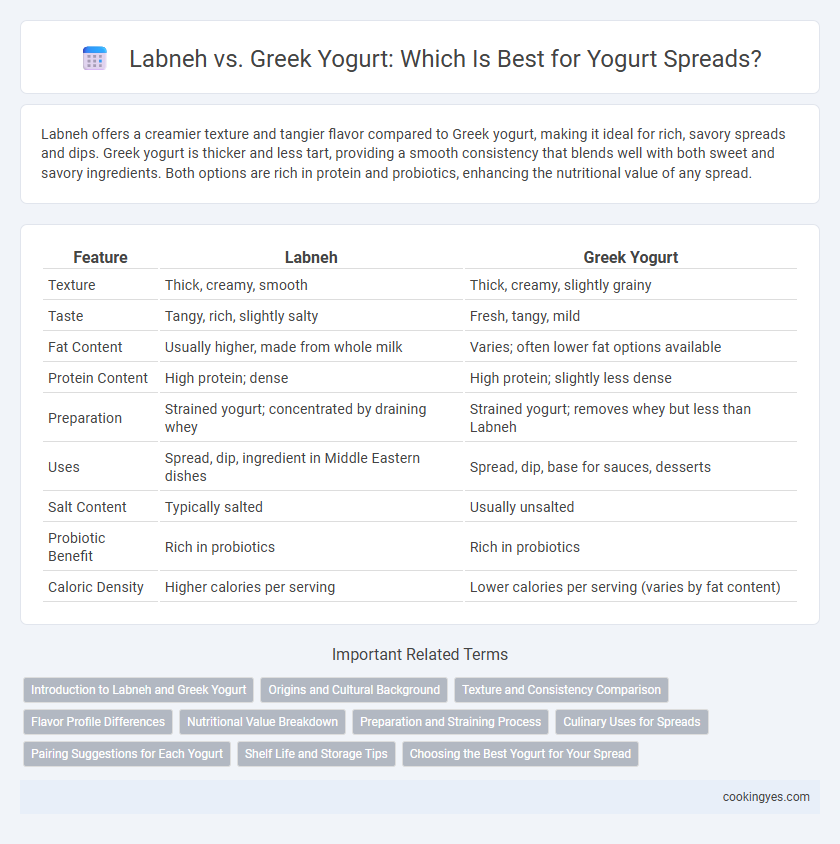Labneh offers a creamier texture and tangier flavor compared to Greek yogurt, making it ideal for rich, savory spreads and dips. Greek yogurt is thicker and less tart, providing a smooth consistency that blends well with both sweet and savory ingredients. Both options are rich in protein and probiotics, enhancing the nutritional value of any spread.
Table of Comparison
| Feature | Labneh | Greek Yogurt |
|---|---|---|
| Texture | Thick, creamy, smooth | Thick, creamy, slightly grainy |
| Taste | Tangy, rich, slightly salty | Fresh, tangy, mild |
| Fat Content | Usually higher, made from whole milk | Varies; often lower fat options available |
| Protein Content | High protein; dense | High protein; slightly less dense |
| Preparation | Strained yogurt; concentrated by draining whey | Strained yogurt; removes whey but less than Labneh |
| Uses | Spread, dip, ingredient in Middle Eastern dishes | Spread, dip, base for sauces, desserts |
| Salt Content | Typically salted | Usually unsalted |
| Probiotic Benefit | Rich in probiotics | Rich in probiotics |
| Caloric Density | Higher calories per serving | Lower calories per serving (varies by fat content) |
Introduction to Labneh and Greek Yogurt
Labneh is a creamy, strained yogurt cheese originating from the Middle East, known for its tangy flavor and thick, spreadable texture, making it a popular choice for savory spreads and dips. Greek yogurt, similarly strained, offers a rich, smooth consistency with high protein content and a slightly tart taste, widely used in Mediterranean cuisine. Both labneh and Greek yogurt provide versatile, nutrient-dense options that enhance the flavor and texture of various dishes while promoting digestive health through probiotics.
Origins and Cultural Background
Labneh, a traditional Middle Eastern strained yogurt, is cherished for its creamy texture and tangy flavor, often used as a versatile spread in Levantine cuisine. Greek yogurt, originating from Greece, undergoes a thicker straining process resulting in a dense, protein-rich spread widely embraced in Mediterranean diets. Both labneh and Greek yogurt hold deep cultural significance, symbolizing their regions' culinary heritage and dietary customs.
Texture and Consistency Comparison
Labneh boasts a creamier, thicker texture with a rich, velvety consistency that makes it ideal for smooth, spreadable applications. Greek yogurt offers a dense yet slightly grainier texture, providing a firmer spread that holds well on bread or crackers. Both provide a tangy flavor but labneh's silky profile distinguishes it as the superior choice for luscious, easily spreadable dips and spreads.
Flavor Profile Differences
Labneh offers a tangier and creamier flavor with a distinct, slightly salty taste due to its strained consistency, making it ideal for savory spreads. Greek yogurt has a milder, more buttery flavor with a thicker texture but less tang, providing a versatile base for both sweet and savory applications. The choice between labneh and Greek yogurt depends on whether a rich, tangy sharpness or a smoother, subtle creaminess is desired in the spread.
Nutritional Value Breakdown
Labneh contains higher protein and lower sugar levels compared to Greek yogurt, making it a nutrient-dense option for spreads. With approximately 10 grams of protein and 3 grams of fat per 100 grams, labneh provides a creamy texture and a probiotic richness that supports digestive health. Greek yogurt, offering around 9 grams of protein and slightly higher calcium content, delivers a tangy flavor and smoother consistency ideal for versatile culinary uses.
Preparation and Straining Process
Labneh is prepared by straining yogurt extensively to remove most of its whey, resulting in a thick, creamy texture ideal for spreads. Greek yogurt undergoes a similar straining process but is typically less dense than labneh, retaining slightly more moisture and tang. The thicker consistency of labneh makes it a richer, more concentrated option compared to Greek yogurt for spreading.
Culinary Uses for Spreads
Labneh offers a rich, creamy texture with a tangy flavor, making it ideal for savory spreads and dips in Mediterranean and Middle Eastern cuisines. Greek yogurt, thicker and less tangy, provides a versatile base for both sweet and savory spreads, blending well with herbs, spices, and fruits. Labneh's higher fat content gives it a spreadable consistency perfect for breads and crackers, while Greek yogurt is often preferred for lighter, healthier options.
Pairing Suggestions for Each Yogurt
Labneh pairs exceptionally well with Mediterranean flavors such as za'atar, olive oil, and fresh herbs like mint or dill, enhancing its creamy, tangy profile. Greek yogurt complements bold toppings like honey, walnuts, and berries, providing a rich base perfect for both savory and sweet spreads. Each yogurt's unique texture and taste offer versatile options for pairing with breads, vegetables, and spices to elevate any appetizer or snack.
Shelf Life and Storage Tips
Labneh, a strained yogurt with a thicker consistency, typically has a shelf life of 1 to 2 weeks when refrigerated at or below 40degF (4degC). Greek yogurt, also strained but less so than Labneh, generally lasts about 1 to 3 weeks under similar refrigeration conditions. To extend freshness, store both Labneh and Greek yogurt in airtight containers away from temperature fluctuations and always use clean utensils to prevent contamination.
Choosing the Best Yogurt for Your Spread
Labneh offers a tangier, creamier texture with higher protein and lower fat, making it ideal for rich, savory spreads that enhance Mediterranean dishes. Greek yogurt provides a thicker, milder taste with a slightly tart flavor and smooth consistency, perfect for versatile spreads that blend well with herbs and spices. Choosing between labneh and Greek yogurt depends on desired creaminess, flavor intensity, and nutritional preferences for your spread.
Labneh vs Greek Yogurt for Spreads Infographic

 cookingyes.com
cookingyes.com